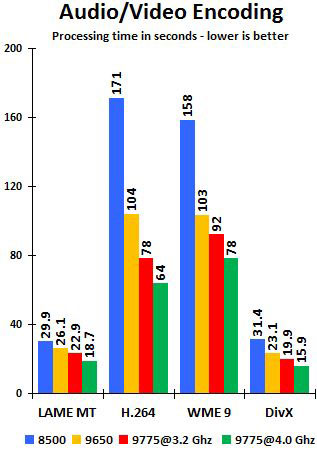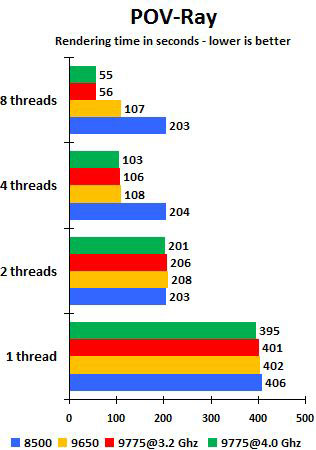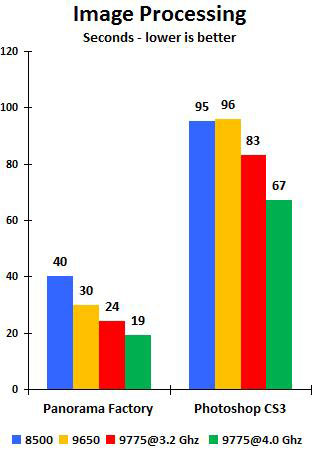|
|
|
|
|
Intel Skulltrail |
|
Join the community - in the OCAU Forums!
|
Gaming, Media Encoding, Image Processing
GAMING
Team Fortress is a first-shooter game based on the “Source” engine and DirectX9. We recorded a short game session and played it back using the built-in time-demo function. Vista’s “Task Manager” shows that TF2 is utilizing 1 core only. The result is clear: Running this game with a quadcore CPU or even dual quadcores will not result in better frame-per-second performance. Half Life 2: Episode 2 is another first-shooter game based on the “Source” engine. We created a demo run and played it back with the “timedemo” command. The results shown are the average frame rates reported back to the console. HL2 is CPU-bound. Frame-per-second performance benefits directly from processing power. It is apparently not running multithreaded though. Running the game with 2-, 4- or 8-cores does not make much of a difference. The result with the QX9775 at 4GHz shows that performance is scaling with processor frequency, but not by adding more cores.
Supreme Commander is a DirectX 9 based strategy game. We utilized the built-in FPS benchmark. SP seems to be very much “GPU bound”, because even at the relatively low resolution of 1024x768 the difference between the E8500 running at 3160 MHz and the 2 x QX9775 running at 4000 MHz is negligible. Apparently neither a quadcore CPU nor a dual quadcore system offers an advantage in this game.
“Lost Planet: Extreme Condition” is the only game that was running truly multithreaded. It has several built-in benchmarks; we are showing here the results for “Cave”. This is the most demanding level, because it comes with a large number of flying doo-dads and other details. Already the QX9650 is providing more than double the number of frames per second in “Cave” than the dualcore E8500. Running the game with the 8-core Skulltrail platform is improving performance by another almost 30%. Lost Planet shows how gaming performance is benefitting from 8 cores if the game is coded to run fully multithreaded. Unfortunately “Lost Planet” is still an exception, and we could not replicate this result with any other game.

We benchmarked Skulltrail with a few more games, such as Quake 4 (not shown). The result was always the same: There is no noticeable impact on frames per second between 4 cores and 8 cores. At 1920x1200 (not shown) the differences between the CPUs became entirely negligible. At higher resolutions frame performance is almost entirely driven by the videocard, even with CPU bound games.
MEDIA ENCODING
“Windows Media Encoder 9” is running multithreaded and therefore making good use of a quad-core processor. We transcoded a 9 MB AVI video clip into a 39 MB WMV file. The quadcore QX9650 is already performing far better than the dual-core E8500, and Skulltrail is another 11% faster than the single quadcore system. “Main Concept” was used to transcode a 40 MB AVI file into the H.264 codec using one of the built-in encoding profiles. Skulltrail is around 25% faster than the QX9650 system. We then used “Virtual Dub” as front-end for DivX to encode a 70 MB MPEG2 source file. Skulltrail is providing around 14% better performance than the QX9650 system. We went on to transcode a 112 MB WAV file to MP3 with the multithreaded version of LAME. Skulltrail did this 11% faster than the 9650 system.
It seems encoding with Skulltrail is a mixed bag. It is between 11% and 25% faster than the single quadcore system. However, a considerable part of this performance gain has to be attributed to the fact that the QX9775 is running with a 200 MHz higher core frequency than the QX9650 and has 1600 MHz FSB frequency instead of a 1333 MHz.

IMAGE PROCESSING
Rendering and image processing tasks are easily broken down into parallel running jobs. They are therefore an ideal application for a multi-core processor. “Cinebench R10” comes with a built-in benchmark. A predefined picture is rendered either single-threaded or with as many threads as cores are available. Skulltrail is unbeatable in this test, because Cinebench R10 takes advantage of every additional core. Skulltrail shows a massive lead of more than 80%. “Panorama Factory” stitches individual images together to create a wide-aspect panorama. We asked the application to “stitch” 4 large, 1920x1080 photos, each 3 MB in size, into a single panorama. The QX9650 is processing the 4 pictures in 30 seconds; Skulltrail is finishing the job in 24 seconds. This is exactly 20% faster. There isn’t much to explain about Adobe’s “Photoshop”. It’s probably the most popular image editing software around. We tested applying 4 filters to a 75 MB picture. Skulltrail is around 14% faster than the single quadcore QX9650 system. The “Persistence of Vision Raytracer”, in short “POV-Ray”, is a ray tracing program for creating 3D-graphics. POV-Ray 3.7 comes with native multithreading. We rendered the 1024x768 demo picture “chess2.pov” with 1, 2, 4 and 8 threads. The results are another testimony to Skulltrail’s processing power: It’s rendering the demo picture almost 50% faster than the QX9650.
 

Enjoying this article? Feel free to Digg it!
|
|
Advertisement:
All original content copyright James Rolfe.
All rights reserved. No reproduction allowed without written permission.
Interested in advertising on OCAU? Contact us for info.
|

|


